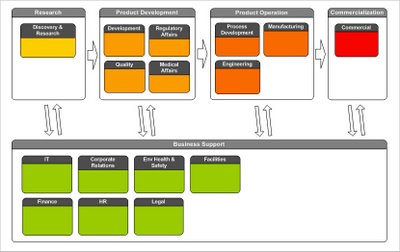ECM-Blog.com
(Enterprise Content Management)
Monday, August 21, 2006
Business Model - Business Item Diagram
 Business Item Diagram captures the relationships and correlations among various business items. Here, business items can be products, manufacturing equipments, real estate properties, and anything that is related to daily business operation of a company. Well-run businesses normally have good definitions of these business items and people from various functional groups use the common terminology when they communicate to one another.
Business Item Diagram captures the relationships and correlations among various business items. Here, business items can be products, manufacturing equipments, real estate properties, and anything that is related to daily business operation of a company. Well-run businesses normally have good definitions of these business items and people from various functional groups use the common terminology when they communicate to one another.
How does this business model analysis help in terms of ECM Modeling? Business events and processes are strongly tied to the dynamics of these business items. Business events, business processes, and business items all spring the need for documentation. Most of the times, taking one-step back and capturing these business item diagrams allow us to develop a convention with which we can build a desirable taxonomy (folder structure) for business documents.
 Business Item Diagram captures the relationships and correlations among various business items. Here, business items can be products, manufacturing equipments, real estate properties, and anything that is related to daily business operation of a company. Well-run businesses normally have good definitions of these business items and people from various functional groups use the common terminology when they communicate to one another.
Business Item Diagram captures the relationships and correlations among various business items. Here, business items can be products, manufacturing equipments, real estate properties, and anything that is related to daily business operation of a company. Well-run businesses normally have good definitions of these business items and people from various functional groups use the common terminology when they communicate to one another.How does this business model analysis help in terms of ECM Modeling? Business events and processes are strongly tied to the dynamics of these business items. Business events, business processes, and business items all spring the need for documentation. Most of the times, taking one-step back and capturing these business item diagrams allow us to develop a convention with which we can build a desirable taxonomy (folder structure) for business documents.
Sunday, August 13, 2006
Business Model – Functional Group Diagram


Shown in the above is an example of a functional group diagram. This diagram captures the make-up of business functional groups and high-level flow of business operation. To be able to put this type of diagram together, you will first have to talk to various functional groups within the organization and ask what the roles and responsibilities are for those groups. It is also important to understand what the company does as a whole and what their core competencies are (How they generate profit).
Tuesday, August 08, 2006
Business Modeling
When conducting Modeling activities for ECM (Enterprise Content Management) solution, it is critical that we understand the Business Model. A Business Model is the design or plan for operations that will offer a product or service of value to a defined set of customers in a way that is beneficial for customers, suppliers, investors, shareholders, and other parties involved. It is the totality of:
When conducting Modeling activities for ECM (Enterprise Content Management) solution, it is critical that we understand the Business Model. A Business Model is the design or plan for operations that will offer a product or service of value to a defined set of customers in a way that is beneficial for customers, suppliers, investors, shareholders, and other parties involved. It is the totality of:
- How it will select, acquire, and manage its customers
- How it defines its products and other business items
- How it goes to the market
- How it organizes its workforce
- How it defines the roles and responsibilities of workforce
- How it defines processes and procedures
- How it captures profit
- Functional Group Diagram
- Product / Business Item Diagram
- Business Goals / Problems
- ECM Vision Statement
Lloyd Lim will share with you his knowledge and experience in Enterprise Content Management (ECM) Implementations in the areas of Business Model Analysis, Information Architecture, ECM Solution Design, ECM Deployment Framework, and ECM Governance.
ECM White Papers
| ECM Governance Program |
Previous Articles
Functional Group Level Information Modeling
Enterprise Level Information Modeling
Information Architecture – How to Organize Corpora...
Business Model - Business Goals, Problems, and ECM...
Business Model - Business Item Diagram
Business Model – Functional Group Diagram
Business Modeling
Unstructured Growth
It all starts from the business
Archives
May 2006 / June 2006 / August 2006 / November 2006 / March 2007 / May 2007 / March 2008 /
Delivered
by FeedBurner
|
Pay
Rent Online! Still writing checks for your rent? Start paying online today. www.SmartRentOnline.com |
|
Watch Super Bowl Commercials Watch Super Bowl Commercials Now. superbowl-commercials-watch-online.com |
|
Discover & follow fashion bloggers - StyleHills.com Connect with top fashion bloggers around the world. stylehills.com |

